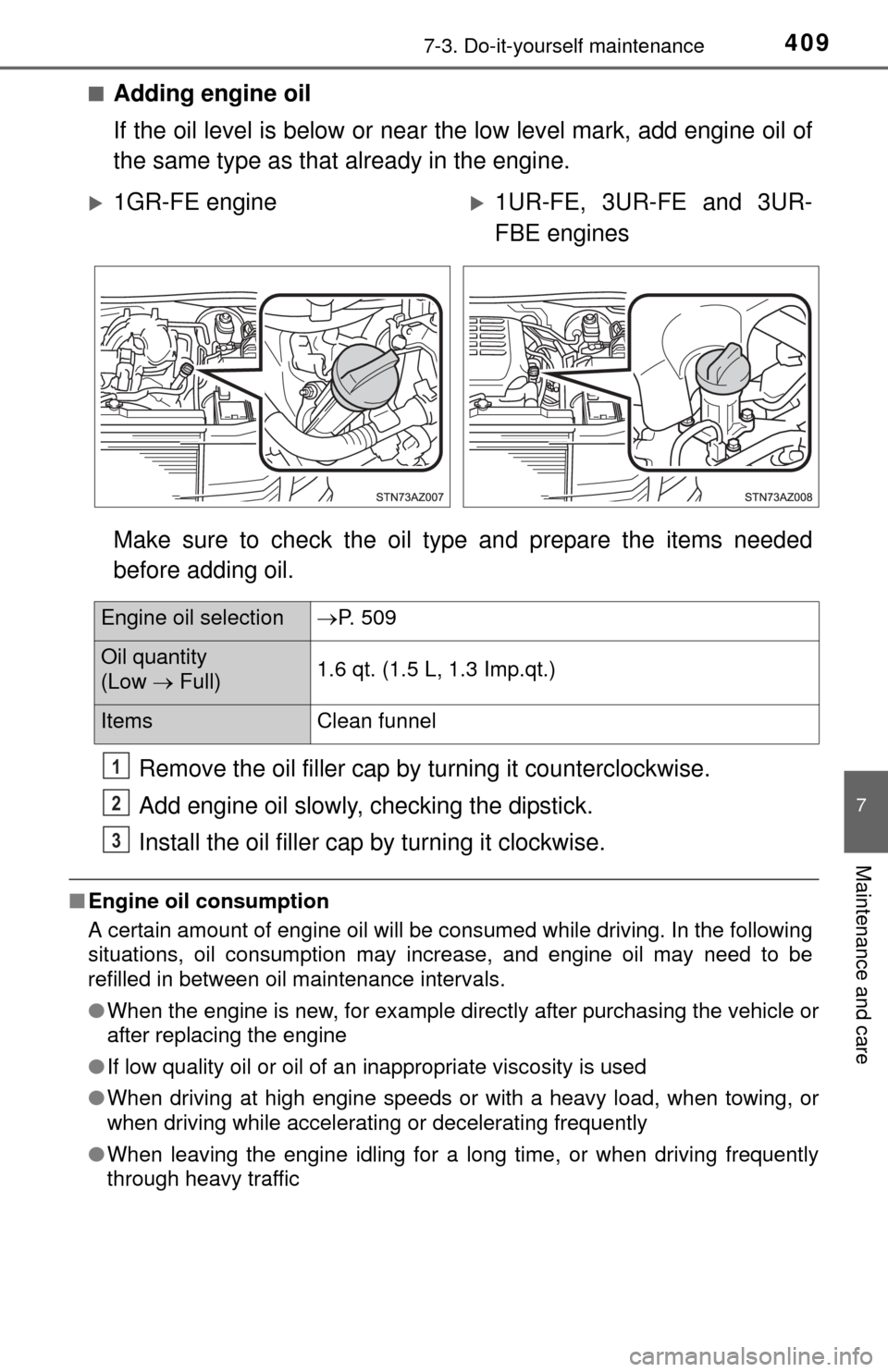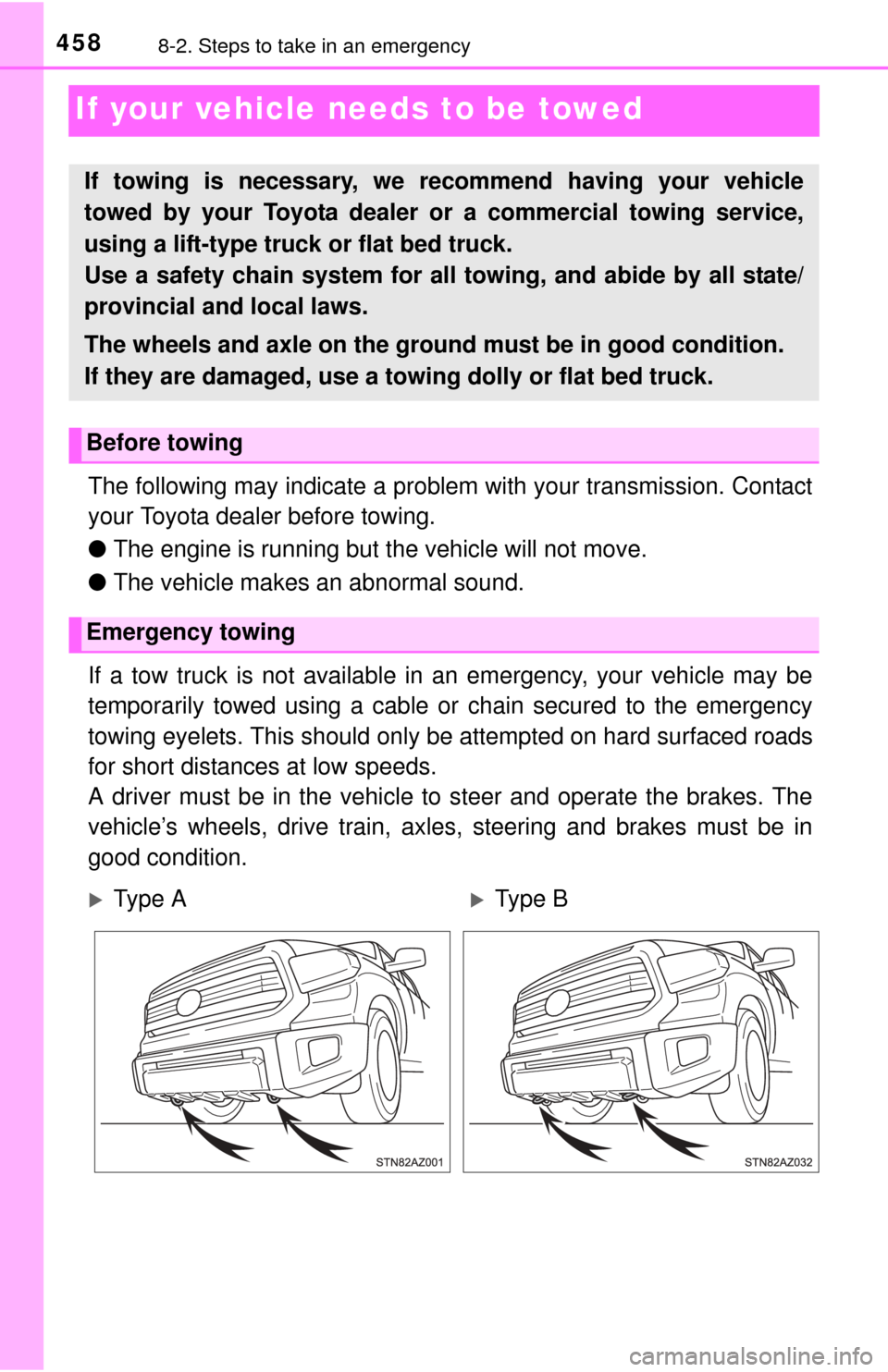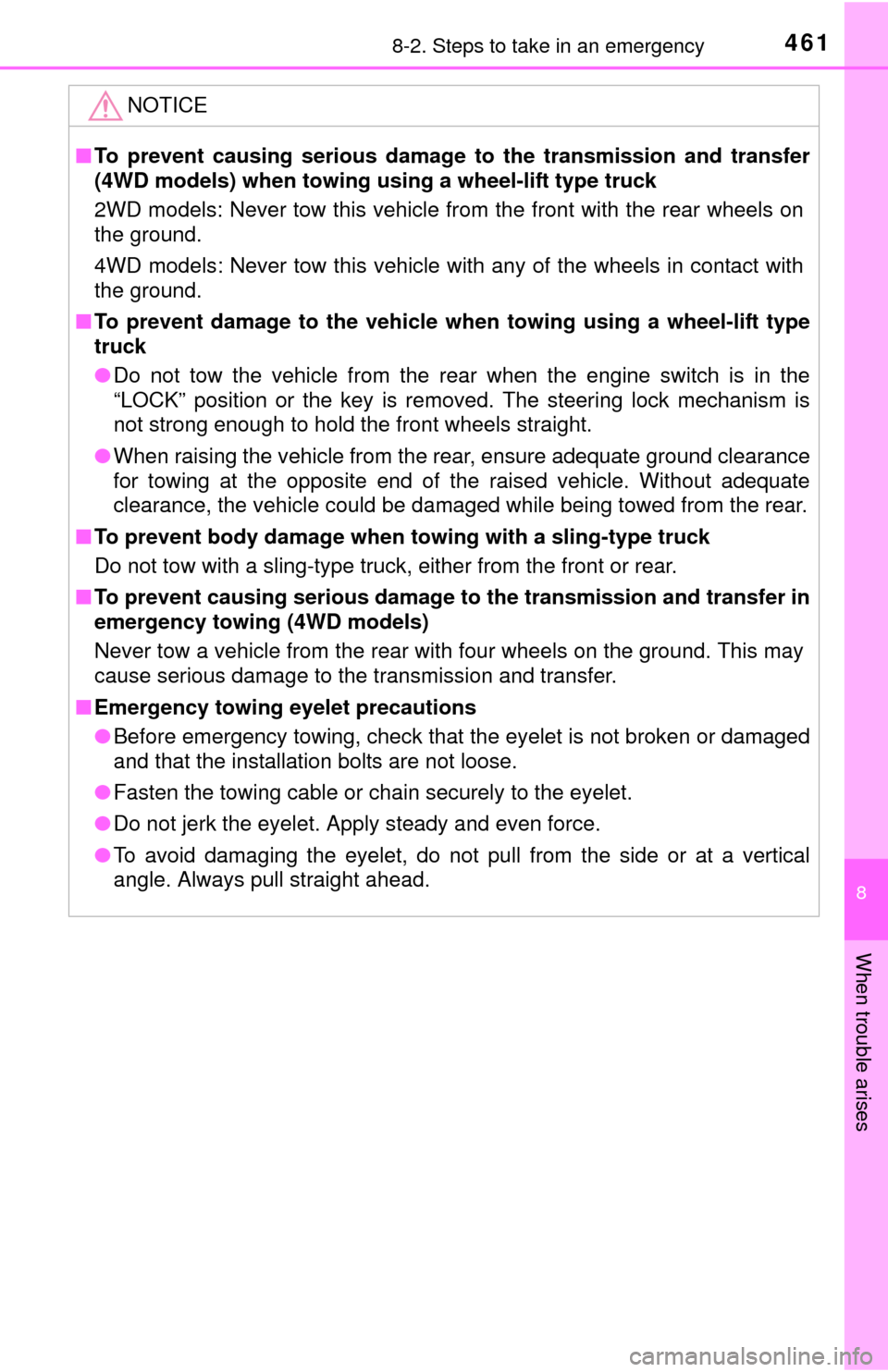Page 409 of 576

4097-3. Do-it-yourself maintenance
7
Maintenance and care
■Adding engine oil
If the oil level is below or near the low level mark, add engine oil of
the same type as that already in the engine.
Make sure to check the oil type and prepare the items needed
before adding oil. Remove the oil filler cap by turning it counterclockwise.
Add engine oil slowly, checking the dipstick.
Install the oil filler cap by turning it clockwise.
■ Engine oil consumption
A certain amount of engine oil will be consumed while driving. In the following
situations, oil consumption may increase, and engine oil may need to be
refilled in between oil maintenance intervals.
●When the engine is new, for example directly after purchasing the vehicle or
after replacing the engine
● If low quality oil or oil of an inappropriate viscosity is used
● When driving at high engine speeds or with a heavy load, when towing, or
when driving while accelerating or decelerating frequently
● When leaving the engine idling for a long time, or when driving frequently
through heavy traffic
1GR-FE engine1UR-FE, 3UR-FE and 3UR-
FBE engines
Engine oil selection P. 509
Oil quantity
(Low Full) 1.6 qt. (1.5 L, 1.3 Imp.qt.)
Items
Clean funnel
1
2
3
Page 422 of 576

4227-3. Do-it-yourself maintenance
●Performance may be affected in the following situations.
• Near a TV tower, electric power plant, gas station, radio station, largedisplay, airport or other facility that generates strong radio waves or
electrical noise
• When carrying a portable radio, cellular phone, cordless phone or other wireless communication device
• If a radio set at similar frequencies is in use in the vehicle
●When the vehicle is parked, the time taken for the warning to start or go
off could be extended.
●When tire inflation pressure declines rapidly for example when a tire has
burst, the warning may not function.
■The initialization operation
●Make sure to carry out in itialization after adjusting the tire inflation pres-
sure.
Also, make sure the tires are cold be fore carrying out initialization or tire
inflation pressure adjustment.
●If you have accidentally turned the engine switch off during initialization,
it is not necessary to press the reset switch again as initialization will
restart automatically when the engine switch has been turned to the
“ON” position for the next time.
●If you accidentally press the reset s witch when initialization is not neces-
sary, adjust the tire inflation pressu re to the specified level when the
tires are cold, and conduct initialization again.
■When initialization of the tire pr essure warning system has failed
Initialization can be completed in a few minutes. However, in the following
cases, the settings have not been recorded and the system will not oper-
ate properly. If repeated attempts to record tire inflation pressure settings
are unsuccessful, have the vehicle inspected by your Toyota dealer.
●When operating the tire pressure wa rning reset switch, the tire pressure
warning light does not blink 3 times.
●After carrying out the initialization procedure, the tire pressure warning
light blinks for 1 minute then stays on after driving for about 20 minutes.
Page 431 of 576
4317-3. Do-it-yourself maintenance
7
Maintenance and care
Air conditioning filter
Turn the engine switch off.
Open the glove box.
Remove the tray.
Remove the cover by sliding up
while pulling toward you.
The air conditioning filter must be changed regularly to maintain
air conditioning efficiency.
Removal method
1
2
3
4
Page 455 of 576
455
8When trouble arises
8-1. Essential informationEmergency flashers .......... 456
If your vehicle has to be stopped in
an emergency ................. 457 8-2. Steps to take in an emergency
If your vehicle needs to be towed ......................... 458
If you think something is wrong .............................. 462
Fuel pump shut off system ............................ 463
If a warning light turns on or a warning buzzer
sounds ............................ 464
If a warning message is displayed (vehicles
with multi-information
display) ........................... 472
If you have a flat tire.......... 475
If the engine will not start ................................. 490
If the shift lever cannot be shifted from P............. 491
If the vehicle battery is discharged ...................... 493
If your vehicle overheats ... 496
If the vehicle becomes stuck ............................... 498
Page 458 of 576

4588-2. Steps to take in an emergency
If your vehicle needs to be towed
The following may indicate a problem with your transmission. Contact
your Toyota dealer before towing.
●The engine is running but the vehicle will not move.
● The vehicle makes an abnormal sound.
If a tow truck is not available in an emergency, your vehicle may be
temporarily towed using a cable or chain secured to the emergency
towing eyelets. This should only be attempted on hard surfaced roads
for short distances at low speeds.
A driver must be in the vehicle to steer and operate the brakes. The
vehicle’s wheels, drive train, axles, steering and brakes must be in
good condition.
If towing is necessary, we re commend having your vehicle
towed by your Toyota dealer or a commercial towing service,
using a lift-type truc k or flat bed truck.
Use a safety chain system for all towing, and abide by all state/
provincial and local laws.
The wheels and axle on the ground must be in good condition.
If they are damaged, use a to wing dolly or flat bed truck.
Before towing
Emergency towing
Ty p e AType B
Page 459 of 576
4598-2. Steps to take in an emergency
8
When trouble arises
Do not tow with a sling-type truck
to prevent body damage.
Towing with a sling-type truck
Towing with a wheel-lift type truck
From the front
Use a towing dolly under the rear
wheels.
From the rear (2WD models)From the rear (4WD models)
Turn the engine switch to the
“ACC” position so that the steer-
ing wheel is unlocked. Use a towing dolly under the
front wheels.
Page 460 of 576
4608-2. Steps to take in an emergency
If you use chains or cables to tie
down your vehicle, the angles
shaded in black must be 45.
Do not overly tighten the tie
downs or the vehicle may be dam-
aged.
■ Before emergency towing
Release the parking brake.
4WD models: Put the front-wheel drive control switch in “2WD”.
Shift the shift lever to N.
Turn the engine switch to the “ACC” (engine off) or the “ON” (engine run-
ning) position.
Using a flat bed truck
CAUTION
Observe the following precautions.
Failure to do so may result in death or serious injury.
■Caution while towing
● Use extreme caution when towing the vehicle.
Avoid sudden starts or erratic driving maneuvers which place excessive
stress on the emergency towing eyelets and the cables or chains. Always
be cautious of the surroundings and other vehicles while towing.
● If the engine is not running, the power assist for the brakes and steering
will not function, making steering and braking more difficult.
1
2
3
4
Page 461 of 576

4618-2. Steps to take in an emergency
8
When trouble arises
NOTICE
■To prevent causing serious damage to the transmission and transfer
(4WD models) when towing using a wheel-lift type truck
2WD models: Never tow this vehicle from the front with the rear wheels on
the ground.
4WD models: Never tow this vehicle with any of the wheels in contact with
the ground.
■ To prevent damage to the vehicle when towing using a wheel-lift type
truck
● Do not tow the vehicle from the rear when the engine switch is in the
“LOCK” position or the key is removed. The steering lock mechanism is
not strong enough to hold the front wheels straight.
● When raising the vehicle from the rear, ensure adequate ground clearance
for towing at the opposite end of the raised vehicle. Without adequate
clearance, the vehicle could be damaged while being towed from the rear.
■ To prevent body damage when towing with a sling-type truck
Do not tow with a sling-type truck, either from the front or rear.
■ To prevent causing serious damage to the transmission and transfer in
emergency towing (4WD models)
Never tow a vehicle from the rear with four wheels on the ground. This may
cause serious damage to the transmission and transfer.
■ Emergency towing eyelet precautions
● Before emergency towing, check that the eyelet is not broken or damaged
and that the installation bolts are not loose.
● Fasten the towing cable or chain securely to the eyelet.
● Do not jerk the eyelet. Apply steady and even force.
● To avoid damaging the eyelet, do not pull from the side or at a vertical
angle. Always pull straight ahead.